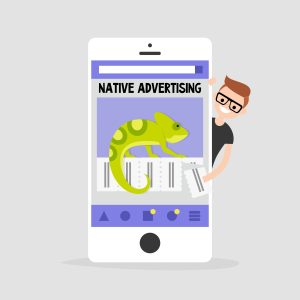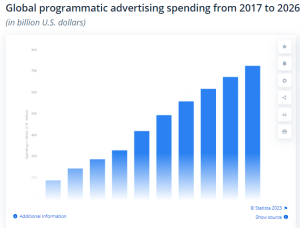The world of digital advertising is constantly evolving, and it can be challenging for marketers to keep up with the latest trends. In recent years, two of the most popular advertising strategies have been programmatic display and native advertising. Both approaches can effectively reach your target audience but have some key differences. In this blog post, we’ll break down the differences between programmatic display and native advertising and help you decide which strategy may be suitable for your brand.
Programmatic Display Advertising: What is it?
Programmatic display advertising is a data-driven approach to reaching audiences across the web. This strategy uses automated technology to deliver ads to specific individuals based on their interests and online behaviors. Programmatic buying allows for highly targeted campaigns that can be adjusted in real-time, making it a highly efficient way to reach consumers.
Programmatic display ads can take many forms, including banner ads, video ads, and native ads. These ads can appear on websites, social media platforms, and even mobile apps. Programmatic display is often used for retargeting campaigns, which display ads to users who have visited a website or taken a particular action. Additionally, you can pair programmatic displays with various digital marketing tactics to increase your ads’ ROI and customer engagement. Digital marketing strategies that work well with programmatic display ads are as follows:
- Geofencing Marketing
- Conversion Zone Tracking
- Site Retargeting
- CRM Retargeting
- Keyword Contextual Tracking
- Event Targeting
- and more!
While programmatic display advertising can be highly effective, it can also be challenging to navigate. Technology can be complex, and there are many factors to consider when setting up a campaign.
Native Advertising: What is it?

Native advertising, on the other hand, is a type of online advertising that matches the form and function of the platform on which it appears. Think of native ads as a sub-section of Programmatic display with a bit more specificity and authenticity. Native advertising can take many forms, including sponsored content, social media posts, and in-feed ads. They are often seen on social media platforms and content websites.
The key benefit of native advertising lies in its ability to provide a more organic and non-disruptive user experience. By blending in with the platform’s content, native ads tend to be less intrusive and more engaging, leading to higher user engagement and, ultimately, better campaign performance. Additionally, native advertising allows brands to leverage the credibility and trust associated with the platform, resulting in improved brand perception and audience reception. The contextual relevance and seamless integration of native ads make them a powerful tool for reaching and resonating with target audiences in an increasingly ad-saturated digital landscape.
However, native advertising can also be misleading, as some users may not realize they are viewing an advertisement. Ensuring clear labeling of your native ad is crucial to avoid confusion.
An important takeaway: Native ads and social media go hand in hand. Leading social media platforms like Facebook, Snap, Instagram, and Twitter have dedicated substantial efforts to create ad experiences seamlessly blend with their distinctive environments over the years. TikTok has followed suit, rapidly establishing itself as a significant player in the native advertising realm since its emergence during the pandemic.
The Statistics of Programmatic Display and Native Advertising
The statistics of programmatic display and native advertising highlight these strategies’ effectiveness and growing popularity in the digital advertising landscape. According to industry reports, global programmatic ad spend is anticipated to reach a staggering $558 million in 2023, showcasing a remarkable 13.1% growth compared to the previous year and nearly doubling its value since 2019. This surge can be attributed to its ability to deliver personalized and targeted ads at scale, resulting in higher engagement rates.

In terms of native advertising, studies indicate that it generates 18% higher engagement compared to traditional banner ads. Furthermore, native ads are estimated to account for nearly 63% of all mobile display ad spending in the United States. These statistics underscore the value of programmatic display and native advertising in capturing audience attention, driving conversions, and achieving campaign objectives in the ever-evolving digital marketing landscape.
Deciding Which Approach is Right for Your Brand
When deciding between programmatic display and native advertising, several factors should be at the forefront. Your budget, target audience, and campaign goals can all play a role in determining which approach may be most effective.
Programmatic display advertising may be the better choice if you want to reach a particular audience. The data-driven approach allows for exact targeting, which can be especially effective for retargeting campaigns.
On the other hand, native advertising may be a better choice if you are looking to increase engagement and brand awareness. Native ads are often seen as more authentic and less intrusive than traditional banner ads, which can help boost click-through rates.
Best Practices for Programmatic and Native Advertising

As digital advertising continues to evolve, programmatic display and native advertising have emerged as two powerful strategies for reaching and engaging audiences. While programmatic display fuses automated technology to deliver targeted ads across a wide range of websites and apps, native advertising blends seamlessly with a platform’s content, providing a more organic and non-disruptive user experience. Both approaches have their strengths and can be effective when implemented correctly. To help you make the most of programmatic display and native advertising, here are some best practices to consider:
- Define Clear Objectives: Before diving into programmatic or native advertising, defining your campaign objectives is essential. Are you aiming to increase brand awareness, drive website traffic, or generate conversions? You can tailor your strategies and metrics by clearly identifying your goals.
- Understand Your Target Audience: Understanding your target audience is crucial for successful programmatic and native campaigns. Utilize data and insights to develop detailed buyer personas, including demographics, interests, and online behavior. This knowledge will guide your ad targeting, ensuring that your messages reach the right people at the right time.
- Craft Compelling and Relevant Content: Whether you opt for programmatic or native advertising, content quality is paramount. Invest time and effort in creating compelling ad copy, visuals, and interactive elements that resonate with your audience. To test what works best, consider designing various ad formats (e.g., static, dynamic, video) for a programmatic display.
- Leverage Data and Analytics: Programmatic advertising relies heavily on data to optimize ad delivery and targeting. Implement robust analytics tools to track key performance indicators (KPIs) such as impressions, click-through rates (CTRs), conversions, and return on ad spend (ROAS). Continuously analyze this data to identify trends, adjust targeting parameters, and refine your campaigns for maximum impact.
- Balance Automation and Human Oversight: Programmatic display heavily relies on automation and algorithms to manage ad placements. While automation streamlines processes, it’s crucial to maintain human oversight.
To summarize, programmatic display and native advertising are two popular strategies for reaching audiences online. While each approach has its strengths and weaknesses, the key is determining which suits your brand’s goals best. Whether you choose programmatic display or native advertising, keep in mind that high-quality content and strategic targeting are essential for a successful digital advertising campaign.


